Transportation development paths in 30 provinces of China in the context of carbon quota allocation
IF 5.7
2区 工程技术
Q1 ECONOMICS
引用次数: 0
Abstract
Establishing a scientific mechanism for allocating carbon allowances in the transportation sector is vital for achieving net-zero emissions targets, especially considering China's significant regional disparities. Nonetheless, the current methods are inadequate. By exploring the causal mechanism of transportation CO2 emissions (TCE), this study addresses the aforementioned gap by developing a carbon allowance allocation method utilizing innovative econometric tools. The method calculates the cost of carbon emission reductions in each province using the non-radial directional distance function (NDDF). We constructed a three-dimensional spatial (SEE) transportation carbon quota allocation model grounded in Stability, Equity, and Efficiency, aimed at facilitating scenario analysis up to 2030. Results highlighted: (1) There is a positive correlation between transportation carbon quotas and the economic scale of each province, with Guangdong Province reaching the highest at about 76 million tons (low-carbon scenarios), further demonstrating that China's transportation carbon emissions have not yet decoupled from economic growth; (2) the marginal carbon abatement costs across provinces vary significantly, exhibiting a pattern of higher costs in the west and lower in the east, with a price range of RMB 40–690 per ton; (3) provinces focused on green transportation, such as Beijing, and those driven by economic driven, like Hebei, can achieve Pareto improvement and balance economic development with carbon emission reductions through reasonable trading. The study provides a methodological basis for China's transportation carbon quota allocation system and offers guidance on selecting development models for different regions.

碳配额分配背景下中国30个省份交通发展路径
在交通运输领域建立科学的碳排放配额分配机制对于实现净零排放目标至关重要,尤其是考虑到中国显著的地区差异。然而,目前的方法是不够的。通过探索交通运输二氧化碳排放的因果机制,本研究利用创新的计量经济学工具,开发了一种碳配额分配方法,解决了上述差距。该方法利用非径向定向距离函数(NDDF)计算各省的碳减排成本。构建了基于稳定、公平和效率的三维交通运输碳配额空间分配模型,旨在促进2030年的情景分析。结果表明:(1)交通运输碳排放配额与各省经济规模呈正相关,其中广东省最高,约为7600万吨(低碳情景),进一步表明中国交通运输碳排放尚未与经济增长脱钩;②各省边际碳减排成本差异显著,呈现出西高东低的格局,价格区间为40 ~ 690元/ t;(3)北京等以绿色交通为主的省份和河北等以经济驱动为主的省份可以通过合理的交易实现帕累托改善,实现经济发展与碳减排的平衡。该研究为中国交通运输碳配额分配制度提供了方法论依据,并为不同地区发展模式的选择提供了指导。
本文章由计算机程序翻译,如有差异,请以英文原文为准。
求助全文
约1分钟内获得全文
求助全文
来源期刊

Journal of Transport Geography
Multiple-
CiteScore
11.50
自引率
11.50%
发文量
197
期刊介绍:
A major resurgence has occurred in transport geography in the wake of political and policy changes, huge transport infrastructure projects and responses to urban traffic congestion. The Journal of Transport Geography provides a central focus for developments in this rapidly expanding sub-discipline.
 求助内容:
求助内容: 应助结果提醒方式:
应助结果提醒方式:


